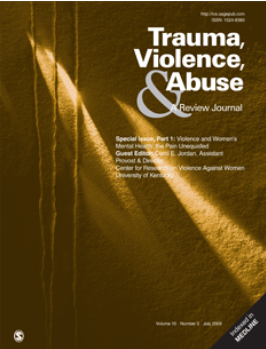不良童年经历与ICD-11创伤后应激障碍或复杂创伤后应激障碍的诊断:系统回顾和三水平荟萃分析
IF 5.4
1区 社会学
Q1 CRIMINOLOGY & PENOLOGY
引用次数: 0
摘要
世界卫生组织国际疾病分类(ICD-11)的第11次修订提出了两种兄弟诊断,即创伤后应激障碍(PTSD)和复杂创伤后应激障碍(CPTSD)。我们的目的是综合评估童年不良经历(ace)与PTSD或CPTSD之间关系的研究。系统检索了7个数据库,确定了24项研究(282个效应量;17075名参与者)。我们进行了单独的三水平随机效应荟萃分析,以检验ace与PTSD与未诊断比率、CPTSD与未诊断比率、CPTSD与PTSD比率之间的关系。对不同的不良反应类型、数量、维度、原因、意图、地点、受害者以及不同原因和地点的共同发生进行调节分析。不良经历导致PTSD比例升高(OR, 1.56;95% CI, 1.38-1.77)和CPTSD (OR, 2.59;95% CI, 1.86-3.61)与未诊断和CPTSD与PTSD的比例较高(OR, 1.70;95% ci, 1.24-2.34)。身体、性和情感虐待、家庭功能障碍以及更广泛的ace综合测量表明,PTSD和CPTSD的风险增加。创伤后应激障碍与创伤后应激障碍的关系受创伤后应激障碍类型和意图的调节。ace与CPTSD的关系受ace的类型、数量、位置以及不同原因和位置的共同发生的影响。ace与CPTSD / PTSD的关系受ace的类型、不同原因和部位的共同发生程度的影响。这些发现强调了ace区分PTSD和CPTSD的风险。本文章由计算机程序翻译,如有差异,请以英文原文为准。
Adverse Childhood Experiences and the Diagnosis of ICD-11 Post-traumatic Stress Disorder or Complex Post-traumatic Stress Disorder: A Systematic Review and Three-level Meta-analysis
The 11th revision of the World Health Organization’s International Classification of Diseases (ICD-11) proposed two sibling diagnoses, namely post-traumatic stress disorder (PTSD) and complex PTSD (CPTSD). We aimed to synthesize studies that evaluated the association between adverse childhood experiences (ACEs) and PTSD or CPTSD. Systematic search of 7 databases identified 24 studies (282 effect sizes; 17,075 participants). Separate three-level random effects meta-analyses were conducted to examine the associations between ACEs and the ratio of PTSD to no diagnosis, CPTSD to no diagnosis, and CPTSD to PTSD. Moderator analyses were conducted with different types, numbers, dimensions, causes, intentions, locations, victims of ACEs, and the co-occurrence of different causes and locations of ACEs. ACEs contributed to higher ratios of PTSD (OR, 1.56; 95% CI, 1.38–1.77) and CPTSD (OR, 2.59; 95% CI, 1.86–3.61) compared to no diagnosis and a higher ratio of CPTSD to PTSD (OR, 1.70; 95% CI, 1.24–2.34). Physical, sexual, and emotional abuse, household dysfunction, and broader composite measures of ACEs characterized increased risks for PTSD and CPTSD. The association between ACEs and PTSD was moderated by the type and intention of ACEs. The association between ACEs and CPTSD was moderated by type, number, location, and the co-occurrence of different causes and locations of ACEs. The association between ACEs and the ratio of CPTSD to PTSD was moderated by type and the co-occurrence of different causes and locations of ACEs. These findings highlight that ACEs distinguish risk for PTSD and CPTSD.
求助全文
通过发布文献求助,成功后即可免费获取论文全文。
去求助
来源期刊

Trauma Violence & Abuse
Multiple-
CiteScore
13.60
自引率
7.80%
发文量
131
期刊介绍:
Trauma, Violence, & Abuse is devoted to organizing, synthesizing, and expanding knowledge on all force of trauma, abuse, and violence. This peer-reviewed journal is practitioner oriented and will publish only reviews of research, conceptual or theoretical articles, and law review articles. Trauma, Violence, & Abuse is dedicated to professionals and advanced students in clinical training who work with any form of trauma, abuse, and violence. It is intended to compile knowledge that clearly affects practice, policy, and research.
 求助内容:
求助内容: 应助结果提醒方式:
应助结果提醒方式:


